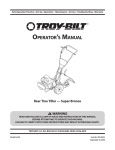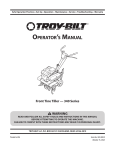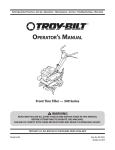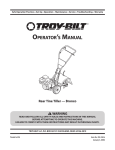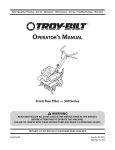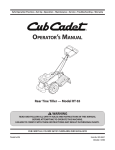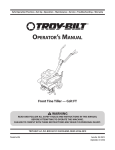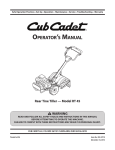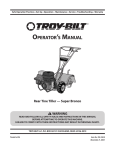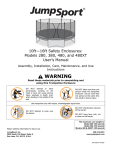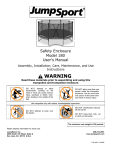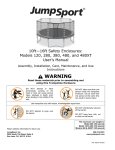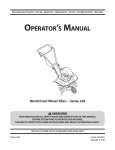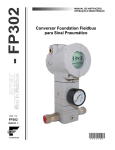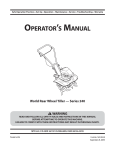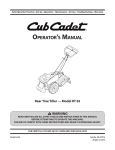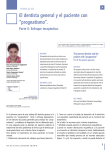Download OperatOr`s Manual - Northern Tool + Equipment
Transcript
Safe Operation Practices • Set-Up • Operation • Maintenance • Service • Troubleshooting • Warranty Operator’s Manual Troy-Bilt 700 Series VTT WARNING READ AND FOLLOW ALL SAFETY RULES AND INSTRUCTIONS IN THIS MANUAL BEFORE ATTEMPTING TO OPERATE THIS MACHINE. FAILURE TO COMPLY WITH THESE INSTRUCTIONS MAY RESULT IN PERSONAL INJURY. TROY-BILT LLC, P.O. BOX 361131 CLEVELAND, OHIO 44136-0019 Printed In China Form No. 769-10107A (October 30, 2014) 1 To The Owner Thank You Thank you for purchasing a Troy-Bilt Garden Tiller, It was carefully engineered to provide excellent performance when properly operated and maintained. If applicable, the power testing information used to establish the power rating of the engine equipped on this machine can be found at www.opei.org or the engine manufacturer’s web site. Please read this entire manual prior to operating the equipment. It instructs you how to safely and easily set up, operate and maintain your machine. Please be sure that you, and any other persons who will operate the machine, carefully follow the recommended safety practices at all times. Failure to do so could result in personal injury or property damage. If you have any problems or questions concerning the machine, phone a authorized Troy-Bilt service dealer or contact us directly. Troy-Bilt’s Customer Support telephone numbers, website address and mailing address can be found on this page. We want to ensure your complete satisfaction at all times. All information in this manual is relative to the most recent product information available at the time of printing. Review this manual frequently to familiarize yourself with the machine, its features and operation. Please be aware that this Operator’s Manual may cover a range of product specifications for various models. Characteristics and features discussed and/or illustrated in this manual may not be applicable to all models. We reserve the right to change product specifications, designs and equipment without notice and without incurring obligation. Throughout this manual, all references to right and left side of the machine are observed from the operating position Table of Contents Safe Operation Practices......................................... 3 Assembly & Set-Up................................................... 7 Controls & Features.................................................10 Operation.................................................................11 Maintenance & Adjustment..................................15 Service......................................................................17 Troubleshooting..................................................... 20 Replacement Parts..................................................21 Warranty................................................................. 24 Record Product Information Model Number Before setting up and operating your new equipment, please locate the model plate on the equipment and record the information in the provided area to the right. You can locate the model plate by standing at the operator’s position and looking down at the top right corner of the tine shield. This information will be necessary, should you seek technical support via our web site, Customer Support Department, or with a local authorized service dealer. Serial Number Customer Support Please do NOT return the machine to the retailer or dealer without first contacting the Customer Support Department. If you have difficulty assembling this product or have any questions regarding the controls, operation, or maintenance of this machine, you can seek help from the experts. Choose from the options below: ◊ Visit us on the web at www.troybilt.com See How-to Maintenance and Parts Installation Videos at www.troybilt.com/tutorials 2 ◊ Call a Customer Support Representative at (800) 828-5500 or (330) 558-7220 ◊ Write to Troy-Bilt LLC • P.O. Box 361131 • Cleveland, OH • 44136-0019 2 Important Safe Operation Practices WARNING! This symbol points out important safety instructions which, if not followed, could endanger the personal safety and/or property of yourself and others. Read and follow all instructions in this manual before attempting to operate this machine. Failure to comply with these instructions may result in personal injury. When you see this symbol. HEED ITS WARNING! CALIFORNIA PROPOSITION 65 WARNING! Engine Exhaust, some of its constituents, and certain vehicle components contain or emit chemicals known to State of California to cause cancer and birth defects or other reproductive harm. WARNING! Battery posts, terminals, and related accessories contain lead and lead compounds, chemicals known to the State of California to cause cancer and reproductive harm. Wash hands after handling DANGER! This machine was built to be operated according to the safe operation practices in this manual. As with any type of power equipment, carelessness or error on the part of the operator can result in serious injury. This machine is capable of amputating fingers, hands, toes and feet. Failure to observe the following safety instructions could result in serious injury or death. Training 1. 2. 3. Read, understand, and follow all instructions on the machine and in the manual(s) before attempting to assemble and operate. Keep this manual in a safe place for future and regular reference and for ordering replacement parts. Be familiar with all controls and their proper operation. Know how to stop the machine and disengage them quickly. Never allow children under 14 years of age to operate this machine. Children 14 and over should read and understand the instructions and safe operation practices in this manual and on the machine and be trained and supervised by an adult. 4. Never allow adults to operate this machine without proper instruction. 5. Keep the area of operation clear of all persons, particularly small children and pets. Stop machine if anyone enters the area. Preparation 1. Thoroughly inspect the area where the equipment is to be used. Remove all stones, sticks, wire, and other foreign objects which could be tripped over and cause personal injury. 2. Wear sturdy, rough-soled work shoes and close fitting slacks and shirt. Loose fitting clothes or jewelry can be caught in moving parts. Never operate this machine in bare feet or sandals. 3. Disengage clutch levers and shift (if provided) into neutral (“N”) before starting the engine. 4. Never leave this machine unattended with the engine running. 5. Never attempt to make any adjustments while engine is running, except where specifically recommended in the operator’s manual. Safe Handling of Gasoline: To avoid personal injury or property damage use extreme care in handling gasoline. Gasoline is extremely flammable and the vapors are explosive. Serious personal injury can occur when gasoline is spilled on yourself or your clothes which can ignite. Wash your skin and change clothes immediately. a. Use only an approved gasoline container. b. Never fill containers inside a vehicle or on a truck or trailer bed with a plastic liner. Always place containers on the ground away from your vehicle before filling. 3 c. When practical, remove gas-powered equipment from the truck or trailer and refuel it on the ground. If this is not possible, then refuel such equipment on a trailer with a portable container, rather than from a gasoline dispenser nozzle. d. Keep the nozzle in contact with the rim of the fuel tank or container opening at all times until fueling is complete. Do not use a nozzle lock-open device. e. Extinguish all cigarettes, cigars, pipes and other sources of ignition. f. Never fuel machine indoors. g. Never remove gas cap or add fuel while the engine is hot or running. Allow engine to cool at least two minutes before refueling. h. Never over fill fuel tank. Fill tank to no more than ½ inch below bottom of filler neck to allow space for fuel expansion. i. Replace gasoline cap and tighten securely. j. If gasoline is spilled, wipe it off the engine and equipment. Move unit to another area. Wait 5 minutes before starting the engine. k. To reduce fire hazards, keep machine free of grass, leaves, or other debris build-up. Clean up oil or fuel spillage and remove any fuel soaked debris. l. Never store the machine or fuel container inside where there is an open flame, spark or pilot light as on a water heater, space heater, furnace, clothes dryer or other gas appliances. Operation 4 1. Do not put hands or feet near rotating parts. Contact with the rotating parts can amputate hands and feet. 2. Do not operate machine while under the influence of alcohol or drugs. 3. Never operate this machine without good visibility or light. Always be sure of your footing and keep a firm hold on the handles. 4. 11. After striking a foreign object, stop the engine, disconnect the spark plug wire and ground against the engine. Thoroughly inspect the machine for any damage. Repair the damage before starting and operating. 12. Disengage all clutch levers (if fitted) and stop engine before you leave the operating position (behind the handles). Wait until the tines come to a complete stop before unclogging the tines, making any adjustments, or inspections. 13. Never run an engine indoors or in a poorly ventilated area. Engine exhaust contains carbon monoxide, an odorless and deadly gas. 14. Muffler and engine become hot and can cause a burn. Do not touch. 15. Use caution when tilling near fences, buildings and underground utilities. Rotating tines can cause property damage or personal injury. 16. Do not overload machine capacity by attempting to till soil too deep at too fast of a rate. 17. If the machine should start making an unusual noise or vibration, stop the engine, disconnect the spark plug wire and ground it against the engine. Inspect thoroughly for damage. Repair any damage before starting and operating. 18. Keep all shields, guards, and safety devices in place and operating properly. 19. Never pick up or carry machine while the engine is running. 20. Use only attachments and accessories approved by the manufacturer. Failure to do so can result in personal injury. 21. If situations occur which are not covered in this manual, use care and good judgement. Contact Customer Support for assistance and the name of you nearest servicing dealer.. Maintenance & Storage 1. Keep machine, attachments and accessories in safe working order. 2. Keep bystanders away from the machine while it is in operation. Stop the machine if anyone enters the area. Allow a machine to cool at least five minutes before storing. Never tamper with safety devices. Check their proper operation regularly. 3. 5. Be careful when tilling in hard ground. The tines may catch in the ground and propel the tiller forward. If this occurs, let go of the handle bars and do not restrain the machine. Check bolts and screws for proper tightness at frequent intervals to keep the machine in safe working condition. Also, visually inspect machine for any damage. 4. 6. Exercise extreme caution when operating on or crossing gravel surfaces. Stay alert for hidden hazards or traffic. Do not carry passengers. Before cleaning, repairing, or inspecting, stop the engine and make certain the tines and all moving parts have stopped. Disconnect the spark plug wire and ground it against the engine to prevent unintended starting. 7. Never operate the machine at high transport speeds on hard or slippery surfaces. 5. 8. Exercise caution to avoid slipping or falling. Do not change the engine governor settings or over-speed the engine. The governor controls the maximum safe operating speed of engine. 9. Look down and behind and use care when in reverse or pulling machine towards you. 6. Maintain or replace safety and instruction labels, as necessary. 10. Start the engine according to the instructions found in this manual and keep feet well away from the tines at all times. 7. Follow this manual for safe loading, unloading, transporting, and storage of this machine. 8. Always refer to the operator’s manual for important details if the machine is to be stored for an extended period. Section 3 — Important Safe Operation Practices 9. If the fuel tank has to be drained, do this outdoors. 10. Observe proper disposal laws and regulations for gas, oil, etc. to protect the environment. 11. According to the Consumer Products Safety Commission (CPSC) and the U.S. Environmental Protection Agency (EPA), this product has an Average Useful Life of seven (7) years, or 130 hours of operation. At the end of the Average Useful Life have the machine inspected annually by an authorized service dealer to ensure that all mechanical and safety systems are working properly and not worn excessively. Failure to do so can result in accidents, injuries or death. Notice Regarding Emissions Engines which are certified to comply with California and federal EPA emission regulations for SORE (Small Off Road Equipment) are certified to operate on regular unleaded gasoline, and may include the following emission control systems: Engine Modification (EM), Oxidizing Catalyst (OC), Secondary Air Injection (SAI) and Three Way Catalyst (TWC) if so equipped. Spark Arrestor WARNING! This machine is equipped with an internal combustion engine and should not be used on or near any unimproved forest-covered, brushcovered or grass-covered land unless the engine’s exhaust system is equipped with a spark arrestor meeting applicable local or state laws (if any). If a spark arrestor is used, it should be maintained in effective working order by the operator. In the State of California the above is required by law (Section 4442 of the California Public Resources Code). Other states may have similar laws. Federal laws apply on federal lands. A spark arrestor for the muffler is available through your nearest engine authorized service dealer or contact the service department, P.O. Box 361131 Cleveland, Ohio 44136-0019. Section 3 — Important Safe Operation Practices 5 Safety Symbols This page depicts and describes safety symbols that may appear on this product. Read, understand, and follow all instructions on the machine before attempting to assemble and operate. Symbol Description READ THE OPERATOR’S MANUAL(S) Read, understand, and follow all instructions in the manual(s) before attempting to assemble and operate WARNING— ROTATING TINES Use extreme caution when reversing or pulling the machine towards you. WARNING— ROTATING TINES Do not put hands or feet near rotating parts. Contact with the rotating parts can amputate hands and feet. WARNING—GASOLINE IS FLAMMABLE Allow the engine to cool at least two minutes before refueling. WARNING— CARBON MONOXIDE Never run an engine indoors or in a poorly ventilated area. Engine exhaust contains carbon monoxide, an odorless and deadly gas. WARNING— HOT SURFACE Engine parts, especially the muffler, become extremely hot during operation. Allow engine and muffler to cool before touching. WARNING! Your Responsibility—Restrict the use of this power machine to persons who read, understand and follow the warnings and instructions in this manual and on the machine. SAVE THESE INSTRUCTIONS! 6 Section 3 — Important Safe Operation Practices 3 Assembly & Set-Up Contents of Carton • One Tiller • One Handlebar Assembly • One Bottle Oil • One Hardware Pack • One Operator’s Manual • One Engine Operator’s Manual WARNING! To prevent personal injury or property damage, do not start the engine until all assembly steps are complete and you have read and understand the safety and operating instructions. Handle 1. Remove the star knob from the handle. See Figure 3-1. 2. Using the shoulder screws, hex lock nuts, flat washers (on the inside of the handle) and bell washers (on the outside of the handle) from the hardware pack, mount the handle to the handle mount plate as shown in Figure 3-2. Recommended Tools for Assembly • One 1⁄2” open-ended wrench or socket • One 5⁄8” open-ended wrench or socket • Scissors (to trim plastic ties) • Tire pressure gauge • Clean oil funnel • Included bottle of oil Contents of Hardware pack • 5⁄16-18 Hex Lock Nut (2) • 5⁄16-18 x .437 x .268 Shoulder Screw (2) • .349 x .879 x .063 Flat Washer (2) • .450 x 1.000 x .062 Bell Washer (2) Assembly Unpacking Instructions 1. Remove the handle by cutting any straps that secure it to the carton and set it aside. 2. Remove any cardboard inserts and packaging material from the carton. Remove any staples from the bottom of the carton and remove the carton. 3. Cut the large, plastic tie straps that secure the tine shield and weight to the shipping pallet. 4. The hardware bag is inside the literature envelope. Check the contents with the list above. 5. The tiller is heavy. You should not attempt to remove it from the shipping platform until instructed to do so in these steps. Figure 3-1 Figure 3-2 7 3. Gently lift the handlebar and place the handlebar brace in the desired height position on the handle mount bracket and secure it in place with the star knob removed in Step 2. See Figure 3-2. 4. Locate the forward (black) and reverse (red) cables on the right side of the handle. Remove any packaging material on the cables being sure not to damage them. 5. The forward (black) cable is routed up the back of the right handle and connected to the clutch bail as shown in Figure 3-3. 9. Route the wire harness up the back of the handle and connect the harness to the ON/OFF switch on the underside of the panel. See Figure 3-4. Red Black Red Figure 3-4 Black 10. Route the neutral cable up the left handle, through the slot in the panel and hook it into the neutral handle. See Figure 3-5. Figure 3-3 6. When the forward (black) cable is correctly connected to the clutch bail, mount the cable in the cable mount bracket. See Figure 3-3. 7. The reverse (red) cable is routed up the right side of the right handle and connected to the reverse handle as shown in Figure 3-3. 8. When the reverse (red) cable is correctly connected to the reverse handle, mount the cable into the cable mount bracket. See Figure 3-3. Figure 3-5 NOTE: Be sure that the spring hook is routed from right to left as shown in Figure 3-6 or the spring will hit the lever. 11. 8 Section 3— Assembly & Set-Up When the cable is properly hooked into the handle, snap it into the cable mount bracket as shown in Figure 3-5. 12. Secure the wires and cables to the handles by using the three cable ties from the hardware pack as shown in Figure 3-6. Tire Pressure Check the air pressure with a tire gauge. Deflate or inflate the tires equally to between 15 and 20 PSI. DO NOT EXCEED 20 P.S.I. NOTE: Be sure that both tires are inflated equally or the tiller will pull to one side. Gas & Oil Fill-Up Service the engine with gasoline and oil as instructed in the separate Engine Operator’s Manual packed with your tiller. Read the instructions carefully. WARNING! Use extreme care when handling gasoline. Gasoline is extremely flammable and the vapors are explosive. Never fuel the machine indoors or while the engine is hot or running. Figure 3-6 13. Place the neutral handle into free wheel (forward drive) position and roll the tiller off the crate. See the Operation section for more information on placing the tiller in the free wheel position. Set-Up Handle The handle should be adjusted so that when the tiller is digging 3-4” into the soil, the handle falls to about waste-high. Loosen the star knob, move the handle to the desired position and then lock into place by tightening the star knob to secure the handle. See Figure 3-7. Figure 3-7 Section 3 — Assembly & Set-Up 9 4 Controls & Features Reverse Handle Clutch Bail Neutral Handle Handlebar Height Adjustment Power Switch Shield Height Adjustment Bracket Tines Neutral Handle Engine Controls See the separate Engine Operator’s Manual for information and functions of the engine controls. Shield Height Adjustment Bracket Reverse Handle The shield height adjustment bracket is used to set the tilling depth. See the Operation section for instructions on using the shield height adjustment bracket. The reverse handle is located on the upper right handle. See the Operation section for instructions on using the reverse handle. Handle Adjustment Lever The handle adjustment lever is used to adjust the handle height and is adjustable to three different settings. See the Assembly & Set-Up section for information and instructions on using the handle adjustment lever. Power Switch The power switch is located on the top/center of the panel. It is used to stop the tiller/engine and must be in the ON position to start the engine. 10 The neutral handle is located on the upper left handle. See the Operation section for instructions on using the neutral handle. OFF ON Clutch Bail The clutch bail is located below the handles. See the Operation section for instructions on using the clutch bail. 5 Operation Starting the Tiller Setting the Depth Pre-Start Checklist To set the tilling depth, remove the depth pin from the shield height adjustment bracket and lift up on the handle. Place the depth pin in the desired hole in front of the tine shield stop and carefully lower the handle. See Figure 5-1. With the spark plug wire disconnected from the spark plug, make the following checks and perform the following services before starting the engine. 1. Read the Safe Operation Practices and Controls & Features Sections in this manual. Read the separate Engine Operator’s Manual. 2. Check the machine for loose or missing hardware. Service as required. 3. Check the engine oil level. See Engine Operator’s Manual. 4. Check that all the safety guards and covers are in place. 5. Check air cleaner. See Engine Operator’s Manual. 6. Attach the spark plug wire to the spark plug. 7. Fill the fuel tank with gasoline according to the directions in the separate Engine Operator’s Manual. Follow all the instructions and safety rules carefully. WARNING! Never run the engine indoors or in enclosed, poorly ventilated areas. Engine exhaust contains carbon monoxide, an odorless and deadly gas. Avoid the engine muffler and nearby areas. Temperatures in these areas may exceed 150° F. Starting the Engine 1. Complete the “Pre-Start Checklist” above. 2. Disengage the tines. 3. Flip the power switch into the ON position, 4. Proceed with the engine starting instructions in your Engine Operator’s Manual. Stopping the Tiller 1. To stop the wheels and tines, release the forward clutch bail or the reverse handle (whichever control is engaged) and place the neutral handle in the disengaged position. 2. To stop the engine place the power switch in the OFF position and follow the instructions in your Engine Operator’s Manual. Figure 5-1 NOTE: The depth pin is keyed and will need to be turned to remove and install into the shield height adjustment bracket. Engaging the Drive & Tines 1. For forward motion of the tines: a. With the neutral handle in the free wheel position, pull the clutch control bail up and hold it against the handlebars. See Figure 5-2. To stop the forward motion of the tines, release the bail. Figure 5-2 11 2. For forward motion of the tines and wheels: a. Engage the neutral handle rearward and the clutch control bail and the tines and wheels will move forward. See Figure 5-3. To stop the forward motion of the tines and wheels, release the bail. Figure 5-3 3. For reverse motion of the tines: a. Pull the reverse handle back to reverse the tines. See Figure 5-4. To stop the reverse motion of the tines, release the reverse handle. Figure 5-4 12 Section 5— Operation 4. For reverse motion of the tines and wheels: a. Engage the neutral handle rearward and the reverse handle and the tines and wheels will move in reverse. See Figure 5-5. To stop the reverse motion of the tines and wheels, release the reverse handle. Figure 5-5 Tilling Tips & Techniques • Tilling Depth WARNING! Before tilling, contact your telephone or When finished in one direction, make a second pass at a right angle, as shown in Figure 5-8. Overlap each pass for the best results (in very hard ground, it may take three or four passes to thoroughly pulverize the soil.) utilities company and inquire if underground equipment/ lines are used on your property. Do not till near buried electric cables, telephone lines, pipes or hoses. • When cultivating (breaking up the surface soil around the plants to destroy weeds, see Figure 5-6), adjust the tines to dig only 1” to 2” deep. Using the shallow tilling depth helps prevent injury to the plants whose roots often grow close to the surface. If needed, lift up on the handlebars slightly to prevent the tines from digging too deeply. (Cultivating on a regular basis not only eliminates weeds, it also loosens and aerates the soil for better moisture absorption and faster plant growth.) Watering the garden area a few days prior to tilling will make tilling easier, as will letting the newly worked soil set for a day or two before making a final, deep tilling pass. Figure 5-8 Tilling on a Slope WARNING! Do not operate the tiller on a slope too steep for safe operation. Till slowly and be sure you have good footing. Never permit the tiller to freewheel down slopes. Failure to follow this warning could result in personal injury. 1. Till only on moderate slopes, never on steep ground where the footing is difficult. 2. Tilling up and down slopes is recommended over terracing. Tilling vertically on a slope allows maximum planting area and also leaves room for cultivating. NOTE: When tilling on slopes, be sure the correct oil level is maintained in the engine (check every one-half hour of operation). The incline of the slope will cause the oil to slant away from its normal level and this can starve engine parts of required lubrication. Keep the motor oil level at the full point at all times. Figure 5-6 Suggested Tilling Patterns • When preparing a seedbed overlap one-half the tiller width on each the passes. See Figure 5-7. Tilling Up and Down a Slope 1. To keep soil erosion to a minimum, be sure to add enough organic matter to the soil so that it has good moisture-holding texture and try to avoid leaving footprints or wheel marks. 2. When tilling vertically, try to make the first pass uphill as the tiller digs more deeply going uphill than it does downhill. In soft soil or weeds, you may have to lift the handlebars slightly while going uphill. When going downhill, overlap the first pass by about one-half the width of the tiller. Section 5 — Operation Figure 5-7 13 Terrace Gardening 1. Loading & Unloading the Tiller WARNING! Loading and unloading the tiller into a vehicle is potentially hazardous and doing so is not recommended unless absolutely necessary, as this could result in personal injury or property damage. To create a terrace, start at the top of the slope and work down. Go back and forth across the first row as shown in Figure 5-9. However, if you must load or unload the tiller, follow the guidelines given next. • Before loading or unloading the tiller, stop the engine, wait for all parts to stop moving, disconnect the spark plug wire and let the engine and muffler cool. • The tiller is too heavy and bulky to be safely lifted by one person. Two or more people should share the load. • Use sturdy ramps and manually — with the engine shut off — roll the tiller into and out of the vehicle. Two or more people are needed to do this. • The ramps must be strong enough to support the combined weight of the tiller and any handlers. The ramps should provide good traction to prevent slipping; they should also have side rails to guide the tiller along the ramps; and they should have a locking device to secure them to the vehicle. • The handlers should wear sturdy footwear that will help to prevent slipping. • Position the loading vehicle so that the ramp angle is as flat as possible (the less incline to the ramp, the better). Turn the vehicle’s engine off and apply the parking brake. • When going up the ramps, stand in the normal operating position and push the tiller ahead of you. Have a person at each side to turn the wheels. • The tines have a self-clearing action which eliminates most of the tangling of debris. However, occasionally dry grass, stringy stalks or tough vines may become tangled. Follow these procedures to help avoid tangling and to clear the tines, if necessary. When going down the ramps, walk backward with the tiller following you. Keep alert for any obstacles behind you. Position a person at each wheel to control the speed of the tiller. Never go down the ramps tiller-first, as the tiller could tip forward. • To reduce tangling, set the depth regulator deep enough to get maximum “chopping” action as the tines chop the material against the ground. Also, try to till under crop residues or cover crops while they are green, moist and tender. Place wooden blocks on the downhill side of the wheels if you need to stop the tiller from rolling down the ramp. Also, use the blocks to temporarily keep the tiller in place on the ramps (if necessary), and to chock the wheels in place after the tiller is in the vehicle. • After loading the tiller, prevent it from rolling by engaging the neutral handle rearward. Chock the wheels with blocks and securely tie the tiller down. UPHILL 1 2 3 12" UNTILLED 1 REPEAT DOWNHILL Figure 5-9 2. Each succeeding lower terrace is started by walking below the terrace you are preparing. For added stability of the tiller, always keep the uphill wheel in the soft, newly tilled soil. Do not till the last 12” or more of the downhill outside edge of each terrace. This untilled strip helps prevent the terraces from breaking apart and washing downhill. It also provides a walking path between the rows. Clearing the Tines • • • While tilling, try swaying the handlebars from side to side (about 6” to 12”). This “fishtailing” action often clears the tines of debris. WARNING! Before clearing the tines by hand, stop the engine, allow all moving parts to stop and disconnect the spark plug wire. Failure to follow this warning could result in personal injury. • 14 If a rock gets jammed between the tines, try using the reverse tines feature to free it. If this does not work, stop the engine, allow all moving parts to stop, disconnect the spark plug wire and use another rock or a rod to dislodge the rock. Section 5— Operation 6 Maintenance & Adjustments Maintenance Schedule Check After First 2 Hours Before Each Use Every 5 Hours Every 10 Hours Every 30 Hours P Clean Engine Check Nuts and Bolts P P P Lubricate Tiller P P P Check Gear Oil Level in Transmission Check Tines for Wear Check Air Pressure in Tires WARNING! Before inspecting, cleaning or servicing the machine, shut off the engine, wait for all moving parts to come to a complete stop, disconnect the spark plug wire and move the wire away from the spark plug. Failure to follow these instructions can result in serious personal injury or property damage. 3. Remove the oil fill plug from the transmission housing and look inside the oil fill hole to locate the main drive shaft situated below the hole. See Figure 6-1. 4. The gear oil level is correct if the gear oil just covers the top of the main drive shaft. 5. If the gear oil level is low, add gear oil as described next. If the gear oil level is okay, securely replace the oil fill plug. Maintenance Engine Refer to the Engine Operator’s Manual for all engine maintenance. Tire Pressure Check the air pressure in both tires. The air pressure should be between 15-20 PSI. Keep both tires equally inflated to help prevent machine from pulling to one side. Hardware Check for loose or missing hardware after every 10 operating hours and tighten or replace — as needed — before reusing the tiller Be sure to check the screws underneath the tiller hood that secure the transmission cover and the Depth Regulator Lever to the transmission. Transmission Gear Oil Check the transmission gear oil after every 30 hours of operation or whenever you notice any oil leak. Operating the tiller when the transmission is low on oil can result in severe damage. To Check the Transmission Gear Oil Level: 1. Check the gear oil level when the transmission is cool. Gear oil will expand in warm operating temperatures and this expansion will provide an incorrect oil level reading. 2. With the tiller on level ground, place the depth pin in the lowest hole to put the unit in the transport position. Figure 6-1 15 6. If adding only a few ounces of gear oil, use API rated GL-4 or GL-5 gear oil having a viscosity of SAE 140, SAE 85W-140 or SAE 80W-90. If refilling an empty transmission, use only GL-4 gear oil having a viscosity of SAE 85W-140 or SAE 140. 7. While checking frequently to avoid overfilling, slowly add gear oil into the oil fill hole until it reaches the halfway point on the drive shaft. 8. Securely replace the oil fill plug. Lubrication After every 10 operating hours, oil or grease the lubrication described below. Use clean lubricating oil (#30 weight motor oil is suitable) and clean general purpose grease (grease containing a metal lubricant is preferred, if available). • Remove the wheels, clean the wheel shaft and apply a thin coating of grease. • Remove the tines and clean the tine shaft. Use a file or sandpaper to gently remove any rust, burrs or rough spots (especially around the holes in the shaft). Apply grease to the ends of the shaft before installing the tines. • Oil the handlebar hardware. Off-Season Storage When the tiller won’t be used for an extended period, prepare it for storage as follows: 1. Clean the tiller and engine. 2. Do routine tiller lubrication and check for loose parts and hardware. 3. Service the engine as instructed in the separate engine manual. 4. Engines stored between 30 and 90 days need to be treated with a gasoline stabilizer such as STA-BIL® and engines stored over 90 days need to be drained of fuel to prevent deterioration and gum from forming in fuel system or on essential carburetor parts. If the gasoline in your engine deteriorates during storage, you may need to have the carburetor, and other fuel system components, serviced or replaced. WARNING: Drain fuel only into an approved container outdoors, away from an open flame. Allow engine to cool. Extinguish cigarettes, cigars, pipes, and other sources of ignition prior to draining fuel. 16 5. Store the tiller in a clean, dry area. 6. Never store the tiller with fuel in the fuel tank in an enclosed area where gas fumes could reach an open flame or spark, or where ignition sources are present (space heaters, hot water heaters, furnaces, etc.). Section 6— Maintenance & Adjustments 7 Service Belt Replacement 3. If the drive belt need to be replaced, it is best to replace all belts at the same time. Use only a factory-authorized belt as an “over- thecounter” belt may not perform satisfactorily. The procedure requires average mechanical ability and commonly available tools. Remove the four hex washer screws that secure the pulley shield to the frame as seen in Figure 7-2, and remove the pulley shield and set aside in a safe location until reinstallation. To replace the Drive and Reverse belts, follow these steps: 1. Make sure the tiller is on a flat surface, with the engine turned off and the spark plug wire unplugged and grounded to prevent unintended firing of the engine. 2. Remove the belt cover as seen in Figure 7-1, by first removing the two 1⁄4-20 hex washer screws and one flat washer. Lift the belt cover up and away from the tiller and set in a safe location until reinstallation. Hex Washer Screws Figure 7-2 4. Figure 7-1 Remove the reverse idler bracket extension spring, as pointed out in Figure 7-3. It is recommended to use a pair of needle-nosed pliers, and grab the spring by the end that hooks over the frame. Simply grab it and pull it away from the frame, then up wards and carefully relieve the tension of the spring. Remove the idler bracket extension spring This belt should be installed with the V-side out Figure 7-3 17 5. Remove the reverse belt from the idler pulley by working it off the pulley and under the belt keepers. 8. Reinstall the transmission drive pulley with the new belts. 9. Reassemble the tiller in the reverse order in which it was disassembled. NOTE: When reinstalling the belt cover, be sure to engage the bail and hold it so that the drive belt is tight while reinstalling the belt cover. This will enable the belt to stay between the belt keeping mechanism built into the belt cover. Failure to do so will damage the belt and/or belt cover. Remove the reverse belt Tines The tines will wear with use and should be inspected at the beginning of each tilling season and after every 30 operating hours. The tines can be replaced. Refer to the Illustrated Parts List manual for part numbers and ordering instructions. Tine Inspection With use, the tines will become shorter, narrower and pointed. Badly worn tines will result in a loss of tilling depth, and reduced effectiveness when chopping up and turning under organic matter. Removing/Installing a Tine Assembly & Tines Figure 7-4 6. Remove the flange nut securing the transmission drive pulley, then remove the pulley along with the reverse belt and the two drive belts. See Figure 7-5. 1. Remove the tine shield by removing the hex lock screw and flat washers securing it to the transmission on each side. 2. A tine assembly consists of a tine bracket and three tines. There are two tine assemblies on the tiller a RH assembly (Part No. 642-05032) and a LH assembly (642-05033). NOTE: Marking the tines and taking note of the different RH and LH assemblies will make re-installing the assemblies properly easier. V-side out 3. Reverse Belt Drive Belts (x2) To remove a tine assembly, simply remove the hex screw and flange lock nut as seen in Figure 7-6. Remove the hex screw and slide the assembly off the tine shaft. Remove pulley with belts Flange Nut Figure 7-5 7. Replace the old belts with the new belts in the same order they were removed. The longer (reverse) belt (954-04091) belongs closer to the engine (V-side out), with the shorter (drive) belts (954-05069) positioned closer to the tines. Figure 7-6 4. 18 Section 7— Service Before reinstalling the tine assembly, inspect the tine shaft for rust, rough spots or burrs. Lightly file or sand, as needed. Apply a thin coat of grease to the shaft. 5. Install the tine assemblies on the proper tine shaft using the hex screw and flange lock nut as seen in Figure 7-6. NOTE: Be sure the tines are installed on the proper side. The tiller will not perform properly if installed incorrectly. 6. To remove and individual tine from the assembly, remove the tine assembly as instructed above and remove the individual tine be removing the hex screw and hex lock nut that secure it to the assembly. NOTE: Like the assemblies, there are specific tines for both the RH (Part No. 742-05076) and LH (742-05091) assemblies. Be certain the tine is the same as the others on the assembly. Change Transmission Gear Oil NOTE: The transmission gear oil does not need to be changed unless it has been contaminated with dirt, sand or metal particles. See an authorized service dealer to have the transmission gear oil changed. Refer to the phone numbers on page 2 of this manual to locate the nearest service dealer. Section 7 — Service 19 8 Troubleshooting Problem Tines do not engage Wheels do not engage Engine does not start 20 Cause Remedy 1. Foreign object lodged in tines. 1. Dislodge foreign object. 2. Tine hardware missing. 2. Replace tine hardware. 3. Pulley and idler not in correct adjustment. 3. Take tiller to authorized service dealer. 4. Belt worn and/or stretched. 4. Replace belt. 1. Nut and bolt missing 1. Replace nut and bolt. 2. Belt worn and/or stretched. 2. Replace belt. 1. Power switch in OFF position. 1. Place the power switch in the ON position. 9 Replacement Parts Component Part Number and Description 754-05069 754-04091 Forward Belt, 4L x 25.4 Reverse Belt, 3L x 29.125 642-05032 742-05076 642-05033 742-05091 RH Tine Assembly RH Tine LH Tine Assembly LH Tine 746-05168 746-04413A 746-04414A Neutral Cable Forward Cable Reverse Cable 629-04157 Wire Harness 634-04232 Tires, 13 x 5 x 6 Phone (800) 828-5500 to order replacement parts or a complete Parts Manual (have your full model number and serial number ready). Parts Manual downloads are also available free of charge at www.troybilt.com. 21 Notes 22 10 Section 10 — Notes 23 MANUFACTURER’S LIMITED WARRANTY FOR The limited warranty set forth below is given by Troy-Bilt LLC with respect to new merchandise purchased and used in the United States and/or its territories and possessions, and by MTD Products Limited with respect to new merchandise purchased and used in Canada and/or its territories and possessions (either entity respectively, “Troy-Bilt”). b. Log splitter pumps, valves, and cylinders have a separate oneyear warranty. c. Routine maintenance items such as lubricants, filters, blade sharpening, tune-ups, brake adjustments, clutch adjustments, deck adjustments, and normal deterioration of the exterior finish due to use or exposure. This warranty is in addition to any applicable emissions warranty provided with your product. d. Service completed by someone other than an authorized service dealer. “Troy-Bilt” warrants this product (excluding its Belts, Transmission and Attachments as described below) against defects in material and workmanship for a period of two (2) years commencing on the date of original purchase and will, at its option, repair or replace, free of charge, any part found to be defective in materials or workmanship. This limited warranty shall only apply if this product has been operated and maintained in accordance with the Operator’s Manual furnished with the product, and has not been subject to misuse, abuse, commercial use, neglect, accident, improper maintenance, alteration, vandalism, theft, fire, water, or damage because of other peril or natural disaster. Damage resulting from the installation or use of any part, accessory or attachment not approved by Troy-Bilt for use with the product(s) covered by this manual will void your warranty as to any resulting damage. e. Troy-Bilt does not extend any warranty for products sold or exported outside of the United States and/or Canada, and their respective possessions and territories, except those sold through Troy-Bilt’s authorized channels of export distribution. f. Replacement parts that are not genuine Troy-Bilt parts. g. Transportation charges and service calls. h. Troy-Bilt does not warrant this product for commercial use. Belts are warranted to be free from defects in material and workmanship for a period of thirty (30) days from the date of purchase. Transmission — Troy-Bilt warrants the transmission (including all gears, shafts and housings) against defects in material and workmanship for the life of the tiller, to the original purchaser only, commencing on the date of original purchase or lease. Attachments — Troy-Bilt warrants attachments for this product against defects in material and workmanship for a period of one (1) year, commencing on the date of the attachment’s original purchase or lease. Attachments include, but are not limited to items such as: grass collectors and mulch kits. HOW TO OBTAIN SERVICE: Warranty service is available, WITH PROOF OF PURCHASE, through your local authorized service dealer. To locate the dealer in your area: In the U.S.A. Check your Yellow Pages, or contact Troy-Bilt LLC at P.O. Box 361131, Cleveland, Ohio 44136-0019, or call 1-866-840-6483, 1-330-558-7220 or log on to our Web site at www.troybilt.com. In Canada Contact MTD Products Limited, Kitchener, ON N2G 4J1, or call 1-800-668-1238 or log on to our Web site at www.mtdcanada.com. This limited warranty does not provide coverage in the following cases: a. The engine or component parts thereof. These items may carry a separate manufacturer’s warranty. Refer to applicable manufacturer’s warranty for terms and conditions. No implied warranty, including any implied warranty of merchantability or fitness for a particular purpose, applies after the applicable period of express written warranty above as to the parts as identified. No other express warranty, whether written or oral, except as mentioned above, given by any person or entity, including a dealer or retailer, with respect to any product, shall bind Troy-Bilt. During the period of the warranty, the exclusive remedy is repair or replacement of the product as set forth above. The provisions as set forth in this warranty provide the sole and exclusive remedy arising from the sale. Troy-Bilt shall not be liable for incidental or consequential loss or damage including, without limitation, expenses incurred for substitute or replacement lawn care services or for rental expenses to temporarily replace a warranted product. Some states do not allow the exclusion or limitation of incidental or consequential damages, or limitations on how long an implied warranty lasts, so the above exclusions or limitations may not apply to you. In no event shall recovery of any kind be greater than the amount of the purchase price of the product sold. Alteration of safety features of the product shall void this warranty. You assume the risk and liability for loss, damage, or injury to you and your property and/or to others and their property arising out of the misuse or inability to use the product. This limited warranty shall not extend to anyone other than the original purchaser or to the person for whom it was purchased as a gift. HOW STATE LAW RELATES TO THIS WARRANTY: This limited warranty gives you specific legal rights, and you may also have other rights which vary from state to state. IMPORTANT: Owner must present Original Proof of Purchase to obtain warranty coverage. Troy-Bilt LLC, P.O. BOX 361131 CLEVELAND, OHIO 44136-0019; Phone: 1-866-840-6483, 1-330-558-7220 MTD Canada Limited - KITCHENER, ON N2G 4J1; Phone 1-800-668-1238 GDOC-100023 REV. C Medidas de seguridad • Configuración • Funcionamiento • Mantenimiento • Servicio • Solución de problemas • Garantía Manual del Operador Troy-Bilt 700 Series VTT ADVERTENCIA LEA Y OBSERVE TODAS LAS NORMAS E INSTRUCCIONES DE SEGURIDAD INCLUIDAS EN ESTE MANUAL ANTES DE PONER EN FUNCIONAMIENTO LA MÁQUINA. SI NO SIGUE ESTAS INSTRUCCIONES PUEDE PROVOCAR LESIONES PERSONALES. TROY-BILT LLC, P.O. BOX 361131 CLEVELAND, OHIO 44136-0019 Impreso en China Formulario No. 769-10107A (30 de Octubre de 2014) 1 Al propietario Gracias Gracias por comprar una cultivadora para jardín Troy-Bilt, ha sido cuidadosamente diseñada para brindar excelente rendimiento si se la opera y mantiene correctamente. Por favor lea todo este manual antes de hacer funcionar el equipo. El manual le indica cómo configurar, operar y mantener la máquina con seguridad y fácilmente. Por favor asegúrese de que usted, y cualquier otra persona que haga funcionar la máquina, sigue atentamente y en todo momento las medidas de seguridad recomendadas. En caso de no hacerlo podrían producirse lesiones personales o daños materiales. Toda la información contenida en este manual hace referencia a la más reciente información de producto disponible en el momento de la impresión. Revise el manual frecuentemente para familiarizarse con la máquina, sus características y funcionamiento. Por favor tenga en cuenta que este Manual del Operador puede cubrir una gama de especificaciones para productos de varios modelos. Es posible que las características y funciones incluidas y/o ilustradas en este manual no se apliquen a todos los modelos. Nos reservamos el derecho de modificar las especificaciones de los productos, diseños y equipos sin previo aviso y sin generar responsabilidad por obligaciones de ningún tipo. Si corresponde, los datos de prueba utilizados para determinar la potencia de salida del motor equipado en esta máquina se pueden consultar en www.opei.org o en el sitio web del fabricante del motor. Si tiene algún problema o duda respecto a la máquina, llame a un distribuidor de servicio Troy-Bilt autorizado o comuníquese directamente con nosotros. En esta página encontrará los números de teléfono, dirección del sitio web y dirección postal de Atención al cliente de Troy-Bilt. Queremos garantizar su entera satisfacción en todo momento. En este manual, todas las referencias al lado derecho e izquierdo de la máquina se observan desde la posición del operador Índice Medidas importantes de seguridad....................... 3 Montaje y Configuración......................................... 7 Controles y Características.....................................10 Operación................................................................11 Mantenimiento y ajustes........................................16 Servicio.....................................................................18 Solución de problemas...........................................21 Garantía...................................................Contratapa Registro de información de producto Número de modelo Antes de configurar y hacer funcionar su equipo nuevo, por favor localice la placa de modelo en el equipo y registre la información en el espacio de la derecha. Encontrará la placa de modelo parándose en la posición del operador y mirando sobre la esquina superior derecha del protector de dientes. Necesitará esta información si tiene que solicitar soporte técnico a través de nuestro sitio web, el Departamento de atención al cliente, o de un distribuidor local de servicio autorizado. Número de serie Asistencia al Cliente Por favor, NO devuelva la máquina al minorista o distribuidor sin ponerse en contacto primero con el Departamento de Asistencia al Cliente. Si tiene dificultad para armar este producto o tiene dudas respecto a los controles, el funcionamiento o el mantenimiento de esta máquina, puede solicitar la ayuda de expertos. Seleccione una de las opciones siguientes: ◊ Visite nuestro sitio web en www.troybilt.com Vea videos instructivos sobre el mantenimiento y la instalación de piezas en www.troybilt.com/tutorials 2 ◊ Llame a un representante de Asistencia al Cliente al (800) 828-5500 ó (330) 558-7220 ◊ Escriba a Troy-Bilt LLC • P.O. Box 361131 • Cleveland, OH • 44136-0019 2 Medidas importantes de seguridad ¡ADVERTENCIA! La presencia de este símbolo indica que se trata de instrucciones importantes de seguridad que se deben respetar para evitar poner en peligro su seguridad personal y/o material y la de otras personas. Lea y siga todas las instrucciones de este manual antes de poner en funcionamiento esta máquina. Si no respeta estas instrucciones puede provocar lesiones personales. Cuando vea este símbolo. ¡TENGA EN CUENTA LAS ADVERTENCIAS! PROPOSICIÓN 65 DE CALIFORNIA ¡ADVERTENCIA! El escape del motor de este producto, algunos de sus componentes y algunos componentes del vehículo contienen o liberan sustancias químicas que el estado de California considera que pueden producir cáncer, defectos de nacimiento u otros problemas reproductivos. ¡ADVERTENCIA! Los bornes de la batería y los accesorios afines contienen plomo y compuestos de plomo, sustancias químicas que según lo establecido por el Estado de California causan cáncer y daños en el sistema reproductivo. Lávese las manos después de estar en contacto con estos componentes. ¡PELIGRO! Esta máquina está diseñada para ser utilizada respetando las normas de seguridad contenidas en este manual. Al igual que con cualquier tipo de equipo motorizado, un descuido o error por parte del operador puede producir lesiones graves. Esta máquina es capaz de amputar dedos (de las manos y/o los pies), manos y pies. De no respetar las instrucciones de seguridad siguientes se pueden producir lesiones graves o la muerte. Capacitación Preparativos 1. Lea, entienda y cumpla todas las instrucciones incluidas en la máquina y en el(los) manual(es) antes de intentar realizar el montaje de la unidad y utilizarla. Guarde este manual en un lugar seguro para consultas futuras y periódicas, así como para solicitar repuestos. 1. Inspeccione minuciosamente el área donde utilizará el equipo. Quite las piedras, palos, alambres y otros objetos extraños con los que se pueda tropezar y provocar lesiones personales. 2. Familiarícese con todos los controles y con el uso adecuado de los mismos. Sepa cómo detener la máquina y desactivar los controles rápidamente. 2. Utilice zapatos de trabajo resistentes, de suela fuerte, así como pantalones y camisas ajustados. Las prendas sueltas y las alhajas se pueden enganchar en las piezas móviles. Nunca opere la máquina descalzo o con sandalias. 3. No permita nunca que los niños menores de 14 años utilicen esta máquina. Los niños de 14 años en adelante deben leer y entender las instrucciones de operación y normas de seguridad contenidas en este manual y en la máquina y deben ser entrenados y supervisados por un adulto. 3. Antes de arrancar el motor, desenganche las palancas del embrague y desplácelas (en caso de haber) a la posición neutral (“N”). 4. Nunca deje la máquina en funcionamiento sin vigilancia. 5. Nunca intente realizar ajustes mientras el motor está en marcha excepto en los casos específicamente 4. Nunca permita que los adultos operen esta máquina sin recibir antes la instrucción apropiada. 5. Mantenga el área de operación despejada de personas, particularmente de niños pequeños y mascotas. Detenga la máquina si alguien se acerca. recomendados en el manual del operador. 3 Manejo seguro de la gasolina: Para evitar lesiones personales o daños materiales tenga mucho cuidado cuando trabaje con gasolina. La gasolina es sumamente inflamable y sus vapores pueden causar explosiones. Si se derrama gasolina encima o sobre la ropa se puede lesionar gravemente ya que se puede incendiar. Lávese la piel y cámbiese de ropa de inmediato. a. Utilice sólo los recipientes para gasolina autorizados. b. Nunca llene los recipientes en el interior de un vehículo o camión o caja de remolque con recubrimiento plástico. Antes de llenarlos, coloque siempre los recipientes en el suelo y lejos del vehículo. Cuando sea factible, retire el equipo a gasolina del camión o remolque y llénelo en el suelo. Si esto no es posible, llene el equipo en un remolque con un contenedor portátil, en vez de hacerlo con una boquilla dispensadora de gasolina. Mantenga la boquilla de llenado en contacto con el borde del depósito de combustible o con la abertura del recipiente en todo momento, hasta terminar la carga. No utilice un dispositivo de boquilla de apertura/cierre. Apague todos los cigarrillos, cigarros, pipas y otras fuentes de combustión. Nunca cargue combustible en la máquina en un espacio cerrado. Nunca saque la tapa de la gasolina ni agregue combustible mientras el motor está caliente o en marcha. Deje que el motor se enfríe por lo menos dos minutos antes de volver a cargar combustible. Nunca llene en exceso el depósito de combustible. Llene el tanque no más de ½ pulgada por debajo de la base del cuello del tapón de carga, para dejar espacio para la expansión del combustible. Vuelva a colocar la tapa de la gasolina y ajústela bien. Limpie el combustible que se haya derramado sobre el motor y el equipo. Traslade la máquina a otra zona. Espere 5 minutos antes de encender el motor. Para reducir el riesgo de incendio, mantenga la máquina limpia de pasto, hojas y de acumulación de otros residuos. Limpie los derrames de aceite o combustible y saque todos los residuos embebidos en combustible. Nunca guarde la máquina o el recipiente de combustible en un espacio cerrado donde haya fuego, chispas o luz piloto, como por ejemplo de calentadores de agua, calefactores de ambientes, hornos, secadores de ropa u otros aparatos a gas. c. d. e. f. g. h. i. j. k. l. 5. 6. 7. 8. 9. 10. 11. 12. 13. 14. 15. 16. 17. 18. 19. 20. 21. Funcionamiento 1. 2. 3. 4. 4 No coloque las manos ni los pies cerca de las piezas giratorias. El contacto con la piezas giratorias puede resultar en la amputación de manos o pies. No utilice la máquina bajo la influencia del alcohol o las drogas. Nunca opere esta máquina sin buena visibilidad o iluminación. Siempre debe estar seguro de que está bien afirmado y sujetando firmemente las manijas. Mantenga a los transeúntes alejados de la máquina mientras la misma está en funcionamiento. Detenga la máquina si alguien se acerca. Sección 2 — Medidas importantes de seguridad Tenga cuidado cuando labre tierras duras. Los dientes pueden clavarse en la tierra e impulsar la cultivadora hacia adelante. Si esto ocurre, suelte el manubrio y deje la máquina libre. Sea sumamente precavido cuando opere la máquina sobre una superficie con grava o cuando la cruce. Manténgase alerta por si se presentan peligros ocultos o tránsito. No transporte pasajeros. Nunca utilice la máquina a altas velocidades de desplazamiento sobre superficies duras o resbaladizas. Tenga cuidado para evitar resbalar o caerse. Mire hacia abajo y hacia atrás y tenga cuidado cuando se desplace en marcha atrás o cuando jale de la máquina hacia usted. Arranque el motor de acuerdo con las instrucciones del manual y mantenga los pies alejados de los dientes en todo momento. Después de golpear con algún objeto extraño, detenga el motor, desconecte el cable de la bujía y conecte el motor a masa. Inspeccione minuciosamente la máquina para ver si está dañada. Repare el daño antes de arrancar y utilizar la máquina. Desenganche todas las palancas de embrague (en caso de haber) y detenga el motor antes de dejar la posición de operación (detrás de las manijas). Espere hasta que los dientes se detengan completamente antes de limpiarlos, hacer algún ajuste o inspeccionarlos. Nunca encienda el motor en espacios cerrados o en una zona con poca ventilación. El escape del motor contiene monóxido de carbono, un gas inodoro y letal. El silenciador y el motor se calientan y pueden causar quemaduras. No los toque. Tenga precaución cuando labre terreno cerca de vallas, edificios y servicios subterráneos. Los dientes rotatorios pueden causar daños materiales o lesiones personales. No sobrecargue la capacidad de la máquina intentando labrar el suelo a un nivel demasiado profundo o a una velocidad demasiado rápida. Si la máquina arranca haciendo un sonido o una vibración rara, detenga el motor, desconecte el cable de la bujía y conéctelo a masa contra el motor. Inspeccione la máquina minuciosamente para ver si está dañada. Repare todos los daños antes de encender y operar la máquina. Mantenga todos los escudos, protectores y dispositivos de seguridad en su lugar y en correcto funcionamiento. Nunca levante o transporte la máquina cuando el motor está encendido. Use sólo aditamentos y accesorios aprobados por el fabricante. Si no lo hace, pueden producirse lesiones personales. Si se presentan situaciones que no están previstas en este manual, tenga cuidado y use el sentido común. Póngase en contacto con Asistencia al Cliente para solicitar ayuda y el nombre del distribuidor de servicio más cercano. Mantenimiento y Almacenamiento 1. 2. 3. Mantenga la máquina, los aditamentos y accesorios en condiciones de funcionamiento seguro. Deje que la máquina se enfríe por lo menos cinco minutos antes de guardarla. Nunca altere los dispositivos de seguridad. Controle periódicamente que funcionen correctamente. Controle frecuentemente que todos los pernos y tornillos estén bien ajustados para comprobar que la máquina se encuentra en condiciones seguras de funcionamiento. Además, haga una inspección visual de la máquina para verificar si está dañada. 4. 5. 6. 7. 8. 9. 10. 11. Antes de limpiar, reparar o inspeccionar la máquina, detenga el motor y asegúrese de que los dientes y todas las partes móviles se hayan detenido. Desconecte el cable de la bujía y póngalo haciendo masa contra el motor para evitar que se encienda accidentalmente. No cambie la configuración del regulador del motor ni lo opere a sobrevelocidad. El regulador del motor controla la velocidad máxima de funcionamiento seguro del motor. Mantenga o reemplace las etiquetas de seguridad e instrucciones según sea necesario. Siga las instrucciones de este manual para cargar, descargar, transportar y almacenar de manera segura esta máquina. Si la máquina se va a almacenar por un período prolongado, consulte siempre el manual del operador para ver los detalles importantes que sean necesarios. Si debe vaciar el tanque de combustible, hágalo al aire libre. Respete las normas referentes a la disposición correcta de residuos y las reglamentaciones sobre gasolina, aceite, etc. para proteger el medio ambiente. Según la Comisión de Seguridad de Productos para el Consumidor de los Estados Unidos (CPSC) y la Agencia de Protección Ambiental de los Estados Unidos (EPA), este producto tiene una vida útil media de siete (7) años ó 130 horas de funcionamiento. Al finalizar la vida útil media, adquiera una máquina nueva o haga inspeccionar anualmente esta unidad por un distribuidor de servicio autorizado para cerciorarse de que todos los sistemas mecánicos y de seguridad funcionan correctamente y no tienen excesivo desgaste. Si no lo hace, pueden producirse accidentes, lesiones o la muerte. Aviso referido a emisiones Los motores que están certificados y cumplen con las regulaciones de emisiones federales EPA y de California para SORE (Equipos pequeños todo terreno) están certificados para operar con gasolina común sin plomo y pueden incluir los siguientes sistemas de control de emisiones: Modificación de motor (EM) y catalizador de tres vías (TWC) si están equipados de esa manera. Amortiguador de chispas ¡ADVERTENCIA! Esta máquina está equipada con un motor de combustión interna y no debe ser utilizada en un terreno agreste cubierto por bosque, malezas o hierba ni cerca del mismo excepto que el sistema de escape del motor esté equipado con un amortiguador de chispas que cumpla con las leyes locales o estatales correspondientes (en caso de haber). Si se utiliza un amortiguador de chispas el operador lo debe mantener en condiciones de uso adecuadas. En el Estado de California las medidas anteriormente mencionadas son exigidas por ley (Artículo 4442 del Código de Recursos Públicos de California). Es posible que existan leyes similares en otros estados. Las leyes federales se aplican en territorios federales. Puede conseguir el amortiguador de chispas para el silenciador a través de su distribuidor de mantenimiento de motores autorizado más cercano o poniéndose en contacto con el departamento de servicios, Apartado Postal 361131 Cleveland, Ohio 44136-0019. Sección 2 — Medidas importantes de seguridad 5 Símbolos de Seguridad Esta página describe los símbolos y figuras de seguridad internacionales que pueden aparecer en este producto. Lea el manual del operador para obtener la información terminada sobre seguridad, reunirse, operación y mantenimiento y reparación. Símbolo Descripción LEA EL MANUAL DEL OPERADOR (S) Lea, entienda, y siga todas las instrucciones en el manual (es) antes de intentar reunirse y funcionar. LA ADVERTENCIA — LOS DIENTES ROTATIVO Tenga mucho cuidado al dar marcha atrás o tirar de la máquina hacia usted . LA ADVERTENCIA — LOS DIENTES ROTATIVO No ponga manos o pies cerca del giro de partes. Contacto con las partes rotativas puede amputar manos y pies. GASOLINA DE ADVERTENCIA ES INFLAMABLE Permita que el motor se enfríe al menos dos minutos antes del reabastecimiento de combustible. ADVERTENCIA — MONÓXIDO DE CARBONO Nunca dirijas un motor dentro o en un área mal ventilada. Los gases de combustión de motor contienen el monóxido de carbono, un gas inodoro y mortal. ADVERTENCIA — SUPERFICIE CALIENTE Las partes del motor, especialmente el silenciador, llega a ser muy caliente durante la operación. Permita motor y silenciador para ponerse frío antes de tocar. ¡ADVERTENCIA! Su responsabilidad—Restrinja el uso de esta máquina motorizada a las personas que lean, comprendan y respeten las advertencias e instrucciones que figuran en este manual y en la máquina. GUARDE ESTAS INSTRUCCIONES 6 Sección 2 — Medidas importantes de seguridad 3 Montaje y Configuración Contenido de la caja de cartón • Una cultivadora • Un conjunto de barra de control • Una botella de aceite • Un paquete de elementos de ferretería • Un Manual del operador • Un Manual de operación del motor ¡ADVERTENCIA! A fin de evitar lesiones personales o daños materiales, no arranque el motor hasta haber terminado todos los pasos de ensamblado y haber leído y comprendido la sección Normas de funcionamiento y la sección Funcionamiento del presente manual. Manija 1. Retire la perilla de estrellas del mango. Vea Figura 3-1. Herramientas recomendadas para el montaje • Dos llaves de cubo o llaves de extremo abierto de 1⁄2” • Tijeras (para recortar precintos plásticos) • Manómetro para tensión de los neumáticos • Limpie el embudo de aceite • Frasco de aceite incluida Contenido del paquete de elementos de ferretería • Tuerca de seguridad hexagonal de 5⁄16-18 (2) • Tornillo con reborde 5⁄16-18 x .437 x .268 (2) • Arandela plana .349 x .879 x .063 (2) • Arandela Belleville .450 x 1.000 x .062 (2) Montaje Instrucciones para desembalar la máquina 1. Retire todos los encartes de cartón y el material de embalaje de la caja. Extraiga las grapas de la base de la caja y saque la caja. 2. Corte la tira plástica grande que asegura el tubo de transmisión al pálet de embarque. Deje las barras de control en la parte superior de la cultivadora para evitar daños a los cables. 3. La bolsa de elementos de ferretería está dentro del sobre con material impreso. Controle el contenido con la lista anterior. 4. La cultivadora es pesada. No debería intentar moverla de la plataforma de embarque hasta que se indique hacerlo en estos pasos. Figura 3-1 2. Use los tornillos con reborde, las tuercas de seguridad hexagonales, las arandelas planas y las arandelas belleville del paquete de herrajes, coloque la manija en la placa de montaje de la manija según se muestra en la Figrua 3-2. Figura 3-2 3. Suavemente levante la barra de control y coloque la traba de la barra de control en la posición de altura deseada sobre el soporte de montaje de la manija y ajústela en su lugar con la perilla estrella que se retiró en el Paso 2. Consulte la Figura 3-2. 7 4. Ubique los cables de marcha adelante (negros) y marcha atrás (rojos) en el lado derecho de la manija. Extraiga todo el material de embalaje o los precintos de los cables sin dañarlos. 5. El cable de marcha adelante (negro) está orientado hacia la parte trasera de la manija derecha y colocado a presión en el soporte de montaje del cable tal como se muestra en la Figura 3-3. Red Rojo Black Red Negro Figura 3-4 10. Rojo Black Pase el cable de enganche de los diente por la manija izquierda, a través de la ranura en el panel, y engánchela en la manija de enganche de los dientes. Consulte la Figura 3-5. Negro Figura 3-3 6. Cuando el cable delantero (negro) esté correctamente instalado sobre el soporte de montaje del cable, instale el accesorio en Z en el enganche del embrague. Consulte la Figura 3-3. 7. El cable de reversa (rojo) está orientado hacia la parte derecha de la manija derecha y colocado a presión en el soporte de montaje del cable tal como se muestra en la Figura 3-3. 8. Cuando el cable delantero (rojo) esté correctamente instalado sobre el soporte de montaje del cable, alimente el cable a través de la ranura en el panel y luego conecte el accesorio en Z en la manija de reversa. Consulte la Figura 3-3. 9. Pase el mazo de cables por atrás de la manija y conecte el mazo al interruptor ON/OFF en la parte inferior del panel. Consulte la Figura 3-4. Figura 3-5 11. 8 Sección 3 — Montaje y Configuración Cuando el cable esté enganchado correctamente en la manija, ajústelo a presión dentro del soporte de montaje del cable tal como se muestra en la Figura 3-5. 12. Asegure los cables a las manijas mediante los dos precintos de los cables del paquete de herrajes tal como se muestra en la Figura 3-6 Presión de los neumáticos Verifique la presión de aire con un manómetro para neumáticos. Infle o desinfle los neumáticos en forma uniforme entre 15 y 20 PSI. NO SUPERE LOS 20 P.S.I. NOTA: Asegúrese que los dos neumáticos estén inflados de manera uniforme, de lo contrario la cultivadora tirará hacia un lado. Llenado de gasolina y aceite Cargue el motor con gasolina y aceite como se indica en el manual del operador del motor por separado que viene con su cultivadora. Lea las instrucciones con atención. ¡ADVERTENCIA! Tenga mucho cuidado al trabajar con gasolina. La gasolina es sumamente inflamable y sus vapores pueden causar explosiones. Nunca agregue combustible a la máquina en espacios cerrados ni mientras el motor está caliente o funcionando. Figura 3-6 13. Coloque la manija neutral en la posición de rueda libre y saque rodando la cultivadora de la caja. Vea la sección Funcionamiento para obtener más información sobre colocar la cultivadora en la posición de rueda libre. Configuración Manija La manija debe ajustarse para que cuando la cultivadora esté labrando a una profundidad de 3-4” en el suelo, la manija se encuentre aproximadamente a la altura de la cintura. Mueva la manija a la posición deseada y luego trábela en su lugar ajustando la perilla estrella para asegurar la manija. Consulte la Figura 3-7. Figura 3-7 Sección 3 — Montaje y Configuración 9 4 Controles y Características Manija de reversa Gancho del embrague Manija neutral Interruptor de energía Ajuste de altura de barra de control Soporte de ajuste de altura del protector Dientes Controles del motor Para conocer datos y funciones de los controles del motor, consulte el Manual del Operador del motor aparte. Soporte de ajuste de altura del protector El soporte de ajuste de altura del protector se usa para fijar la profundidad de cultivo. Para cambiar la profundidad de cultivo, retire el pasador de profundidad del soporte y levante la manija. Coloque el pasador de profundidad en el orificio deseado y baje la manija. Ajuste de altura de barra de control El ajuste de altura de barra de control está ubicado en frente del protector de los dientes entre los brazos bajos de las manijas. La manija se puede ubicar en tres posiciones diferentes. Para ajustar la manija, suelte la perilla estrella, mueva la manija a una de las tres posiciones disponibles y vuelva a apretar la perilla estrella para asegurarla en su lugar. Interruptor de energía El interruptor de energía está ubicado en el lado derecho del panel. Se usa para detener la cultivadora/ el motor y debe estar en la posición ON para OFF ON encender el motor. 10 Manija neutral La manija neutral está ubicada en la manija izquierda superior. Cuando la manija neutral está en la posición hacia adelante (desenganchada) la cultivadora está en neutral y las ruedas están en "rueda libre". Para enganchar las ruedas (adelante o en reversa), tire de la manija neutral hacia atrás hasta la posición de enganche. La manija neutral continuará en la posición de enganche hasta que se vuelva a colocar en la posición de rueda libre. Manija de reversa La manija de reversa está ubicada en la manija derecha superior. Cuando la manija de reversa se tira atrás a la posición de reversa, los dientes y las ruedas (si está enganchada la manija neutral) se moverán en reversa. Para activar el movimiento de reversa solo de los dientes, enganche la manija de reversa con la manija neutral en la posición de rueda libre. Cuando se suelta la manija de reversa, regresará a la posición hacia adelante (desenganchada) y los dientes y las ruedas dejarán de moverse. Gancho del embrague El gancho del embrague está ubicado debajo de las manijas. Cuando el gancho del embrague está desenganchado, los dientes no girarán. Cuando el gancho de embrague se tira hacia arriba contra las manijas en la posición de enganche, los dientes se engancharán y rotarán hacia adelante hasta que el motor se detenga o el gancho del embrague se suelte. Cuando la manija neutral también esté en la posición de enganche, esto permitirá que los dientes y las ruedas se muevan hacia adelante. 5 Funcionamiento Encendido de la cultivadora Ajuste de la profundidad Lista de control previa al arranque Para fijar la profundidad de cultivo, retire el pasador de profundidad del soporte de ajuste de altura del protector, mueva el protector de los dientes a la posición deseada y vuelva a insertar el pasador de profundidad. Consulte la Figura 5-1. Con el cable de la bujía desconectado de la bujía, realice los siguientes controles y el siguiente mantenimiento antes de encender el motor. 1. Lea las secciones de Medidas de seguridad y Controles y funciones en este manual. Lea el Manual del operador del motor que se entrega por separado. 2. Verifique si la máquina tiene herrajes sueltos o faltantes. Realice el mantenimiento necesario. 3. Revise el nivel de aceite del motor. Consulte el Manual del operador del motor. 4. Compruebe que todas las protecciones y cubiertas de seguridad estén en su sitio. 5. Controle el filtro de aire y el sistema de enfriamiento del motor. Consulte el Manual del operador del motor. 6. Conecte el cable de la bujía a la bujía. 7. Cargue gasolina en el depósito de combustible de acuerdo con las instrucciones que figuran en el Manual del operador del motor que se entrega por separado. Respete atentamente todas las instrucciones y las normas de seguridad. ¡ADVERTENCIA! Nunca haga funcionar el motor en interiores o en zona cerradas, con ventilación insuficiente. El escape del motor contiene monóxido de carbono, un gas inodoro y letal. Evite el silenciador del motor y las superficies circundantes. Las temperaturas de dichas superficies pueden superar los 150° F. Figura 5-1 NOTA: El pasador de profundidad tiene llave y necesitará girarse para extraerse e instalarse en el soporte de ajuste de altura del protector. Encendido del motor 1. Complete la "Lista de control previa al arranque". 2. Desenganche los dientes. 3. Coloque el interruptor de energía en la posición ON. 4. Continúe con las instrucciones de encendido del motor de su Manual del operador del motor. Detener la cultivadora 1. Para detener las ruedas y los dientes, suelte el gancho del embrague de marcha adelante o la manija de reversa (cualquiera de los controles que esté enganchado) y coloque la manija de enganche de los dientes en la posición de desenganche. 2. Para detener el motor coloque el interruptor en la posición OFF y siga las instrucciones de su Manual del operador del motor. Enganche de la transmisión y dientes 1. Para movimiento hacia adelante de los dientes: a. Tire el gancho de control del embrague hacia arriba con la manija neutral en la posición de rueda libre, la manija de reversa desenganchada y mantenga contra las barras de control. Vea la Figura 5-2. Para detener el movimiento hacia adelante de los dientes, suelte el enganche. Figura 5-2 11 2. Para movimiento hacia adelante de los dientes y las ruedas: a. Enganche la manija neutral y el enganche de control del embrague con la manija de reversa desenganchada y las ruedas y los dientes se moverán hacia adelante. Vea la Figura 5-3. Para detener el movimiento hacia adelante de los dientes y las ruedas, suelte el enganche. Figura 5-3 3. Para movimiento en reversa de los dientes: a. Tire la palanca de reversa hacia atrás con la manija neutral en la posición de rueda libre y el enganche de control del embrague desenganchado para dar reversa a los dientes. Vea la Figura 5-4. Para detener el movimiento en reversa de los dientes, suelte la manija de reversa. Figura 5-4 12 Sección 5 — Funcionamiento 2. Para movimiento en reversa de los dientes y las ruedas: a. Enganche la manija neutral y la maija de reversa, con el enganche de control del embrague desenganchado y las ruedas y los dientes se moverán en reversa. Vea la Figura 5-5. Para detener el movimiento en reversa de los dientes y las ruedas, suelte la manija de reversa. Figura 5-5 Cultivador Consejos y técnicas Patrones de cultivo de terreno sugeridos Cultivador Profundidad • ADVERTENCIA! Antes de labrar, póngase en contacto con su teléfono o de los servicios públicos compañía y preguntar si los equipos subterráneos / líneas se utilizan en su propiedad. No lo hagas hasta cerca de los cables eléctricos enterrados, líneas telefónicas, tuberías o mangueras. • Cuando se prepara un lecho de siembra solapar la mitad del ancho de la cultivadora en cada uno de los pases. Vea la Figura 5-7. Cuando el cultivo (ruptura de la superficie del suelo alrededor de las plantas para destruir las malezas, vea la Figura 5-6), ajuste los dientes para cavar sólo 1 “a 2” de profundidad. El uso de la profundidad de labranza poco profunda ayuda a prevenir lesiones a las plantas cuyas raíces crecen a menudo cerca de la superficie. Si es necesario, levante el manillar ligeramente para evitar que los dientes caven demasiado profundo. (Cultivando sobre una base regular no sólo elimina las malas hierbas, también afloja y airea el suelo para una mejor absorción de humedad y más rápido crecimiento de la planta.) Irrigación la zona de jardín de unos pocos días antes de la labranza hará más fácil la labranza, como dejando que el suelo recién trabajado establecido por un día o dos antes de tomar una, pasada final labranza profunda. Figure 5-7 • Cuando haya terminado en una dirección, hacer una segunda pasada en un ángulo recto, como se muestra en la Figura 5-8. Traslape cada pasada para los mejores resultados. Figure 5-6 Figure 5-8 Sección 5 — Funcionamiento 13 Labranza en una pendiente ¡ADVERTENCIA! No opere la cultivadora en una pendiente demasiado empinada para una operación segura. Hasta que poco a poco y asegurarse de que tiene buen pie. Nunca permita que la cultivadora en rueda libre por pendientes. El incumplimiento de esta advertencia puede ocasionar lesiones personales. 1. Hasta que sólo en pendientes moderadas, nunca en terreno escarpado donde la igualdad es difícil. 2. Tilling y abajo de las pendientes, se recomienda más de terrazas. La labranza vertical en una pendiente permite un área de plantación máxima y también deja espacio para el cultivo. Terraza Jardinería 1. Para crear una terraza, comience en la parte superior de la pendiente y trabaje hacia abajo. Ir hacia atrás y adelante a través de la primera fila, como se muestra en la Figura 5-9. UPHILL 1 2 3 NOTA: Al realizar la labranza en pendientes, asegúrese de que el nivel de aceite correcto se mantiene en el motor (compruebe cada uno de media hora de operación). La inclinación de la pendiente hace que el aceite se mueva en sentido oblicuo respecto de su nivel normal y esto puede matar de hambre a las piezas del motor de la lubricación necesaria. Mantenga el nivel de aceite del motor en el punto más alto en todo momento. 12" UNTILLED 1 REPEAT DOWNHILL Cultivar Arriba y abajo de una cuesta 1. 2. Para mantener a la erosión del suelo al mínimo, asegúrese de agregar suficiente materia orgánica al suelo de modo que tenga una buena textura de humedad de retención y tratar de evitar dejar huellas o marcas de ruedas. Al realizar la labranza verticalmente, trate de hacer la primera pasada hacia arriba ya que la cultivadora cava con mayor profundidad cuando sube que cuando baja. En suelo blando o malas hierbas, puede que tenga que levantar el manillar ligeramente al ir cuesta arriba. Cuando va cuesta abajo, traslape la primera pasada por alrededor de la mitad de la anchura de la caña del timón. Figure 5-9 2. Cada terraza inferior sucesiva comienza caminando por debajo de la terraza que está preparando. Para mejorar la estabilidad de la cultivadora, siempre mantenga la rueda cuesta arriba en el suelo blando, recién labrada. No hasta que los últimos 12 “o más de la cuesta abajo fuera de borde de cada terraza. Esta franja sin labrar ayuda a evitar que las terrazas de romperse y el lavado cuesta abajo. También proporciona un sendero para caminar entre las hileras. Despejar los dientes • Los dientes tienen una acción de auto-compensación que elimina la mayor parte del enredo de escombros. Sin embargo, de vez en cuando la hierba seca, tallos fibrosos o enredaderas resistentes pueden engancharse. Siga estos procedimientos para ayudar a evitar que se enreden y para limpiar los dientes, si es necesario. • Para reducir el enredo, ajuste el regulador de profundidad lo suficientemente profunda para obtener el máximo de acción “picar”, como los dientes cortan el material contra el suelo. Además, trate de hasta debajo de los residuos de cultivos o cultivos de cobertura mientras están verdes, húmedas y licitación. ¡ADVERTENCIA! Antes de despejar los dientes a mano, apague el motor, permita que todas las partes en movimiento se detengan y desconecte el cable de la bujía. El incumplimiento de esta advertencia puede ocasionar lesiones personales. • 14 Sección 5 — Funcionamiento Si una roca se atasca entre los dientes, pruebe a utilizar las púas inversa cuentan para liberarlo. Si esto no funciona, apague el motor, permita que todas las partes en movimiento se detengan, desconecte el cable de la bujía y el uso de una varilla o un tubo para desalojar la roca. Carga y descarga de la sierpe ¡ADVERTENCIA! Carga y descarga de la cultivadora en un vehículo es potencialmente peligrosa y al hacerlo no se recomienda a menos que sea absolutamente necesario, ya que esto podría resultar en lesiones personales o daños a la propiedad. Sin embargo, si debe cargar o descargar la caña del timón, sigue las instrucciones dadas próximo. • Antes de cargar o descargar la caña del timón, apague el motor, espere a que todas las partes a dejar de moverse, desconecte el cable de la bujía y deje que el motor y el silenciador fresco. No intente cargar y / o descargar la caña del timón mientras se está ejecutando. • El timón es demasiado pesado y voluminoso que se levante con seguridad por una sola persona. Dos o más personas deben compartir la carga. • Use rampas resistentes y manualmente - con el motor apagado - rodar el timón dentro y fuera del vehículo. Dos o más personas se necesitan para hacer esto. • Las rampas deben ser lo suficientemente fuerte como para soportar el peso combinado de la cultivadora y de los cargadores. Las rampas deben proporcionar una buena tracción para evitar resbalones; también deben tener rieles laterales para guiar el timón a lo largo de las rampas; y deben tener un dispositivo de bloqueo para asegurar al vehículo. • Los cargadores deben usar calzado resistente que los ayude a evitar resbalones. • Coloque el vehículo de carga de modo que el ángulo de la rampa es lo más plana posible (cuanto menos inclinada sea la rampa, mejor). Encienda el motor del vehículo y aplique el freno de estacionamiento. • Al subir las rampas, de pie en la posición de funcionamiento normal y empujar el timón por delante de ti. Tener una persona a cada lado para girar las ruedas. • Al bajar las rampas, camine hacia atrás con el timón siguiente. Manténgase alerta para cualquier obstáculo detrás de usted. Colocar a una persona en cada rueda para controlar la velocidad de la caña del timón. Nunca bajar la caña del timón rampas-en primer lugar, como el timón podría inclinar hacia adelante. • Coloque bloques de madera en el lado cuesta abajo de las ruedas si es necesario para detener la cultivadora mientras baja la rampa. Además, use los bloques para mantener temporalmente el timón en lugar de las rampas (si es necesario), y para calzar las ruedas en su lugar después de que el timón está en el vehículo. • Después de cargar la caña del timón, evitar que ruede por la participación del mango neutral hacia atrás. Bloquee las ruedas con bloques y segura empatar el timón hacia abajo. Sección 5 — Funcionamiento 15 6 Mantenimiento y Ajustes Programa de mantenimiento Control al cabo de las primeras 2 horas Controle las tuercas y los pernos Cada 5 horas Cada 10 horas Cada 30 horas P Limpie el motor Controle la tensión de la correa de transmisión Antes de cada uso P P P P P Lubrique la cultivadora P P P Controle el nivel de aceite para engranajes de la transmisión Controle el desgaste de los dientes Controle la presión de aire de los neumáticos ¡ADVERTENCIA! Antes de realizar la inspección, la limpieza o el mantenimiento de la máquina, apague el motor, espere hasta que detengan completamente todas las piezas móviles, desconecte el cable de la bujía y aléjelo de la bujía. Si no se cumplen dichas instrucciones se pueden producir graves lesiones personales o daños materiales. 2. Con la cultivadora sobre suelo nivelado, coloque el pasador de profundidad en la posición más alta. 3. Extraiga el tapón de llenado de aceite del alojamiento de la transmisión y mire en el interior del orificio de llenado de aceite para ubicar el eje del accionamiento principal que está ubicado debajo del orificio. Consulte la Figura 6-1. Mantenimiento Motor Consulte el Manual del operador del motor para obtener información sobre todo el mantenimiento del motor. Presión de los neumáticos Verifique la presión de aire en los dos neumáticos. La presión de aire se debe encontrar entre 15 PSI y 20 PSI. Mantenga los dos neumáticos inflados de forma uniforme para evitar que la máquina tire hacia un lado. Herrajes Verifique si hay herrajes sueltos o faltantes cada 10 horas de operación y ajústelos o cámbielos (según sea necesario) antes de volver a usar la cultivadora Asegúrese de inspeccionar los tornillos que están debajo de la cubierta de la cultivadora que sujetan la cubierta de la transmisión y la palanca del regulador de profundidad a la transmisión. Aceite para la transmisión/los engranajes Controle el aceite para la transmisión/los engranajes siempre cada 30 horas de funcionamiento o cuando note alguna pérdida de aceite. Si se opera la cultivadora cuando la transmisión tiene poco aceite, se pueden producir daños graves. Para controlar el nivel de aceite de la transmisión/los engranajes: 1. 16 Controle el nivel del aceite de los engranajes cuando la transmisión esté fría. El aceite para engranajes se dilatará a las temperaturas altas de funcionamiento y dicha dilatación proporcionará una lectura del nivel de aceite incorrecta. Figura 6-1 4. El nivel de aceite de engranajes es correcto si el aceite de engranajes sólo cubre la parte superior del eje de accionamiento principal.. 5. Si el nivel del aceite para engranajes es bajo, agregue aceite para engranajes como se describe a continuación. Si el nivel de aceite de engranajes está bien, vuelva a colocar de manera segura el tapón de llenado de aceite. 6. Si se desea agregar únicamente unas onzas de aceite para engranajes, utilice aceite API de grado GL-4 ó GL-5 de viscosidad SAE 140, SAE 85W-140 ó SAE 80W-90. Si recarga la transmisión por encontrarse vacía, use únicamente un aceite GL-4 con viscosidad SAE 85W-140 ó SAE 140. 7. Mientras controla con frecuencia para evitar llenar en exceso, agregue lentamente el aceite de engranajes dentro del orificio de llenado de aceite hasta que llegue al punto medio del eje de accionamiento. 8. Vuelva a colocar de manera segura el tapón de llenado de aceite. Lubricación Después de cada 10 horas de funcionamiento, aceite o engrase los puntos de lubricación. Use aceite lubricante limpio (es adecuado el aceite para motores de peso #30) y grasa de uso general limpia (es preferible grasa que contenga un lubricante de metal, si hay disponible). • Retire las ruedas, limpie el eje de las ruedas y aplíquele una capa delgada de grasa. • Engrase la parte posterior, el frente y los costados de la palanca del regulador de profundidad. • Retire los dientes y limpie el eje de los dientes. Use una lima o papel de lija para quitar suavemente cualquier óxido, rebabas o asperezas (especialmente alrededor de los orificios del eje). Aplique grasa a los extremos del eje antes de instalar los dientes. • Lubrique las roscas de los tornillos de sujeción de altura de la barra de control y los tornillos de fijación de la barra de control. Almacenamiento fuera de temporada Si la cultivadora no se va a usar durante un período prolongado, prepárela para el almacenamiento de la siguiente forma: 1. Limpie la cultivadora y el motor. 2. Realice la lubricación de rutina de los dientes y verifique si hay herrajes o piezas sueltas. 3. Realice el mantenimiento del motor como se indica en el manual del motor por separado. 4. Para almacenar motores entre 30 y 90 días es necesario tratarlos con un estabilizador de gasolina como el STA-BIL® y para almacenarlos durante más de 90 días se debe drenar el combustible para evitar deterioros y la formación de depósitos de goma en el sistema de combustible o en piezas fundamentales del carburador. Si la gasolina en su motor se deteriora durante el almacenamiento, es posible que deba reparar o reemplazar el carburador y otros componentes del sistema de combustible. ADVERTENCIA: Drene el combustible solo dentro de un recipiente aprobado y al aire libre, lejos de una llama expuesta. Deje que el motor se enfríe. Apague cigarrillos, cigarros, pipas y otras fuentes de combustión antes de drenar el combustible. 5. Almacene la cultivadora en un área limpia y seca. 6. Nunca almacene la cultivadora con combustible en el depósito en un área cerrada donde las emanaciones de la gasolina pueden alcanzar una llama expuesta o chispas, o donde hubiere fuentes de encendido (calefactores, calentadores de agua, hornos, etc.). Sección 6 — Mantenimiento y Ajustes 17 7 Servicio Cambio de correa 3. Si se desea reemplazar la correa de transmisión, lo mejor es reemplazar ambas correas al mismo tiempo. Use únicamente correas autorizadas por el fabricante, ya que las correas genéricas pueden no desempeñarse satisfactoriamente. El procedimiento requiere habilidad mecánica media y herramientas habitualmente disponibles. Retire los cuatro tornillos de arandela hexagonal que sujetan la cubierta de la polea al bastidor como se observa en la Figura 7-2, y extraiga dicha cubierta y colóquela a un lado en un lugar seguro hasta que vuelva a instalarla. Para reemplazar la correa de transmisión y reversa, siga estos pasos: 1. Compruebe que la cultivadora esté sobre una superficie plana, con el motor apagado y el cable de la bujía desenchufado y puesto a tierra para evitar el encendido accidental del motor. 2. Retire la cubierta de la correa como se observa en la Figura 7-1, extrayendo primero los dos tornillos de arandela hexagonal de 1⁄4-20 y una arandela plana. Levante la cubierta de la correa, aléjela de la cultivadora y colóquela en un lugar seguro hasta que vuelva a instalarla. Arandela hexagonal Tornillos Figura 7-2 4. Figura 7-1 Extraiga el resorte de extensión de la ménsula intermedia, tal como se muestra en la Figura 7-3. Se recomienda usar un par de pinzas de punta de aguja, y sujetar el resorte por el extremo que se engancha sobre el bastidor. Simplemente, sujételo y tire para sacarlo del bastidor, luego hacia arriba y con cuidado suelte la tensión del resorte. Extraiga el resorte de extensión de la ménsula intermedia Esta correa debería estar instalada con el lado V hacia afuera Figura 7-3 18 5. Retire la correa reversa de la polea loca por trabajar fuera de la polea y bajo los fijadores de las correas. Vea la Figura 7-4. 8. Vuelva a instalar la polea de transmisión con las nuevas correas. 9. Ensamble nuevamente la cultivadora en el orden inverso al seguido para el desensamblado. NOTA: Cuando vuelva a instalar la cubierta de la correa, asegúrese de activar el rescate y mantenerlo de forma que la correa de transmisión es escaso, mientras que volver a instalar la cubierta de la correa. Esto permitirá que el cinturón para alojarse entre el mecanismo de mantenimiento de cinturón integrado en la cubierta de la correa. De no hacerlo, podría dañar el cinturón y / o cubierta de la correa. Retire la correa reversa Dientes Los dientes se desgastan con el uso y se los debe inspeccionar al comienzo de cada temporada de labranza y a intervalos de 30 horas de funcionamiento. Los dientes se pueden reemplazar. Consulte el manual del listado ilustrado de piezas para obtener los números de piezas y las instrucciones para los pedidos. Inspección de los dientes Con el uso, los dientes se acortan, se angostan y se vuelven puntiagudos. El uso de dientes muy desgastados ocasionarán pérdida de profundidad de la labranza y se reducirá la eficacia para cortar y girar debajo de la materia orgánica. Figura 7-4 6. Extraiga la tuerca de brida que sujeta la polea de transmisión, luego retire la polea junto con las dos correas. Consulte la Figura 7-5. Lado V hacia afuera Correa Reversa Retiro/Instalación de un conjunto de dientes y dientes 1. Para extraer el protector de dientes retire el tornillo de protección hexagonal y las arandelas planas que lo sujetan a la transmisión de cada lado. 2. Un conjunto de dientes está compuesto por un soporte de dientes y tres dientes. La cultivadora tiene dos conjuntos de dientes, un conjunto del LADO DERECHO (Pieza N° 642-05032) y un conjunto de LADO IZQUIERDO (642-05033). NOTA: Si marca los dients y tiene en cuenta los distintos conjuntos de lado derecho e izquierdo será más fácil cuando desee volver a instalar los conjuntos adecuadamente. correa de transmisión (x2) Extraiga la polea con correas Tuerca con reborde 3. Para retirar un conjunto de dientes, simplemente retire el tornillo hexagonal y la tuerca de seguridad de brida tal como se muestra en la Figura 7-6. Retire el tornillo hexagonal y deslice el conjunto hacia afuera del eje de los dientes. Figura 7-5 7. Reemplace las correas viejas por las nuevas en el mismo orden en que se extrajeron. La correa más larga (954-04091) va más cerca del motor (lado V hacia afuera), con la correa más corta (954-05069) colocada más cerca de los dientes. Figura 7-6 Sección 7 — Servicio 19 4. Antes de volver a instalar el conjunto de dientes, inspeccione el eje de los dientes para verificar si esta oxidado, tiene asperezas o rebabas. Lime o lije ligeramente, según sea necesario. Aplique al eje una capa delgada de grasa. 5. Instale los conjuntos de dientes en el eje de dientes adecuado con el tornillo hexagonal y la tuerca de seguridad de brida tal como se muestra en la “Figura 7-6”. 6. Para retirar un diente del conjunto, extraiga el conjunto de dientes según se indica arriba y retire el diente que desee, quitando el tornillo hexagonal y la tuerca de seguridad hexagonal que lo ajustan al conjunto. NOTA: Como los conjuntos, hay dientes específicos para cada conjunto de LADO DERECHO (Pieza N° 742-05076) y LADO IZQUIERDO (742-05091). Asegúrese de que el diente sea el mismo que los demás en el conjunto. Cambio de aceite para la transmisión/ los engranajes NOTA: El aceite para la transmisión/los engranajes no debe cambiarse a menos que se haya contaminado con suciedad, arena o partículas metálicas. Consulte a un distribuidor de servicio autorizado para el cambio del aceite para la transmisión/los engranajes. Consulte los números de teléfono en la página 2 del presente manual para ubicar el distribuidor de servicio más cercano. 20 Sección 7 — Servicio 8 Solución de Problemas Problema Los dientes no enganchan Las ruedas no enganchan El motor no se enciende. Causa Solución 1. Hay un objeto extraño en los dientes. 1. Libere el objeto extraño. 2. Faltan herrajes de dientes. 2. Reemplace los herrajes de dientes. 3. La polea y la polea intermedia no están ajustadas correctamente. 3. Lleve la cultivadora al distribuidor de servicio autorizado. 4. La correa está desgastada y/o estirada. 4. Reemplace la correa. 1. Faltan tuerca y perno. 1. Reemplace tuerca y perno. 2. La correa está desgastada y/o estirada. 2. Reemplace la correa. 1. Interruptor de energía en posición OFF (apagado). 1. Coloque el interruptor de energía en la posición ON (encendido). 21 Notas 22 9 Section 9 — Notas 23 GARANTÍA LIMITADA DEL FABRICANTE PARA La siguiente garantía limitada es otorgada por Troy-Bilt LLC con respecto a nuevos productos adquiridos y utilizados en Estados Unidos y/o sus territorios y posesiones, y por MTD Products Limited con respecto a nuevos productos adquiridos y utilizados en Canadá y/o sus territorios y posesiones (cualquiera de las dos entidades, respectivamente, “Troy-Bilt”). Esta garantía es adicional a la garantía de emisiones aplicables proporcionada con el producto. “Troy-Bilt” garantiza este producto (excluidas las Correas, Transmisión y Accesorios según se describe más abajo) contra defectos en los materiales y mano de obra por un período de dos (2) años a partir de la fecha de compra original y, a su opción, reparará o reemplazará, sin costo alguno, cualquier pieza que presente defectos en los materiales o de mano de obra. Esta garantía limitada sólo se aplicará si el producto ha sido operado y mantenido de acuerdo con las instrucciones del Manual del Operador que se proporciona con el producto y no ha sido sujeto a uso inapropiado, abuso, uso comercial, abandono, accidente, mantenimiento incorrecto, alteración, vandalismo, robo, incendio, inundación o algún daño debido a otro peligro o desastre natural. El daño resultante por la instalación o el uso de piezas, accesorios o aditamentos no aprobados por Troy-Bilt para su uso con el(los) producto(s) incluido(s) en este manual anulará la garantía en lo que respecta a esos daños. Las correas se garantiza para estar libres de defectos en material y la ejecución por un período de treinta (30) días a partir de la fecha de la compra. Transmisión - Troy-Bilt garantiza la transmisión (todos los engranajes incluyendo, los ejes y las cubiertas) contra defectos en material y la ejecución para la vida de la sierpe, al comprador original solamente, comenzando la fecha de la compra o del arriendo original. Accesorios — Troy-Bilt garantiza que los accesorios de este producto están libres de defectos de material y mano de obra durante un período de un (1) año a partir de la fecha de compra o arrendamiento original del accesorio. Los accesorios incluyen, pero no se limitan a: colectores de césped y kits para abono. CÓMO SOLICITAR Y OBTENER SERVICIO TÉCNICO: El servicio de la garantía está disponible, CON PRUEBA DE COMPRA, a través del distribuidor de servicio local autorizado. Para localizar al distribuidor de su zona: En Estados Unidos de América Consulte las páginas amarillas, o póngase en contacto con Troy-Bilt LLC en P.O. Box 361131, Cleveland, Ohio 44136-0019, llame al 1-866-840-6483, 1-330-558-7220 ó visite nuestro sitio web en www.troybilt.com. En Canadá Póngase en contacto con MTD Products Limited, Kitchener, ON N2G 4J1, llame al 1-800-668-1238 ó visite nuestro sitio web en www. mtdcanada.com. Esta garantía limitada no suministra cobertura en los siguientes casos: a. El motor o las piezas que lo componen. Estos productos pueden tener garantía del fabricante por separado. Consulte los términos y condiciones de la garantía aplicable del fabricante. b. Las bombas, válvulas y cilindros del rompetroncos tienen una garantía separada de un año. c. Los artículos necesarios para el mantenimiento de rutina como por ejemplo lubricantes, filtros, afiladores de cuchillas, sincronización del motor, los ajustes de los frenos, del embrague o de la plataforma y el deterioro normal del acabado exterior debido al uso o exposición. d. Mantenimiento no realizado por el distribuidor de servicio autorizado. e. Troy-Bilt no extiende ninguna garantía para los productos vendidos o exportados fuera de los Estados Unidos de América y/o Canadá, y sus respectivas posesiones y territorios, excepto para aquellos vendidos a través de los canales autorizados de distribución de exportaciones de Troy-Bilt. f. Piezas de reemplazo que no son piezas originales de Troy-Bilt. g. Gastos de transporte y visitas técnicas. h. Troy-Bilt no garantiza este producto para uso comercial. No existe ninguna garantía implícita, incluyendo cualquier garantía implícita de comerciabilidad o adaptabilidad para un propósito en particular, una vez transcurrido el período aplicable de garantía escrita según lo antedicho en relación con las piezas identificadas. Ninguna otra garantía expresa, ni oral ni escrita, excepto la mencionada anteriormente, extendida por personas reales o jurídicas, incluidos los distribuidores o los minoristas con respecto a cualquier producto, obligará a Troy-Bilt. Durante el plazo de la garantía el único recurso es la reparación o reemplazo del producto como se indicó anteriormente. Las disposiciones de esta garantía cubren el recurso de reparación única y exclusiva que surge de la venta. Troy-Bilt no se hará responsable de ninguna pérdida o daño incidental o resultante, incluyendo sin limitación, los gastos incurridos para los servicios de mantenimiento del césped, o los gastos de arrendamiento para reemplazar de manera transitoria un producto bajo garantía. Algunos estados no permiten la exclusión o limitación de los daños y perjuicios incidentales o directos, o las limitaciones sobre la duración de las garantías implícitas, por lo que las exclusiones o limitaciones mencionadas anteriormente pueden no serle de aplicación. En ningún caso se obtendrá una compensación de ningún tipo por un monto mayor al precio de compra del producto vendido. La alteración de las características de seguridad del producto anulará esta garantía. Usted asume el riesgo y la responsabilidad de las pérdidas, daños o lesiones que sufran usted y sus bienes y / u otras personas y sus bienes como resultado del uso incorrecto o de la falta de capacidad para usar este producto. Esta garantía limitada cubre solamente al comprador original, o a la persona que recibió el producto de regalo. CÓMO SE RELACIONA LA LEGISLACIÓN ESTATAL CON ESTA GARANTÍA: Esta garantía limitada le otorga derechos legales específicos y usted también puede contar con otros derechos que varían de un estado a otro. IMPORTANTE: El propietario debe presentar prueba de compra original para obtener la cobertura de la garantía. Troy-Bilt LLC, P.O. BOX 361131 CLEVELAND, OHIO 44136-0019, Teléfono: 1-866-840-6483, 1-330-558-7220 MTD Canada Limited - KITCHENER, ON N2G 4J1; Teléfono 1-800-668-1238 GDOC-100023 REV. C
















































